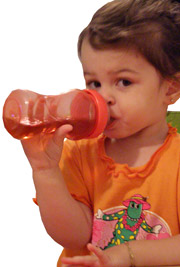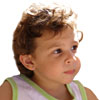- Major motor skills
- Fine motor skills
- Language
- Vision and hearing
- Social achievements and play
- When to be concerned
Major motor skills

Fine motor skills
Children should now be able to turn pages singularly. They enjoy naming objects on request. Children should be able to build a tower of six blocks and imitate circular scribble. They should be able to put on their hat and shoes (without laces), use a spoon competently, and lift and replace a cup without spilling.
Language
Their vocabulary should include the use of at least 50 words (often up to 200), including the use of two or more words together to form simple sentences. They should be able to give their first name.
Vision and hearing
Children should demonstrate everyday visual competence for near and far.
Social achievements and play
A 2 year old is beginning to explore widely. They will play near other children (but usually not very cooperatively or ‘with’ other children). They have trouble sharing and are fearful of separation from their caregivers. They are generally dry during the daytime. Children will often talk continuously to themselves during play and should engage in simple imaginative play. Caregivers report that they will play contentedly alone, but like to remain close to the caregiver.
When to be concerned
Speak to your doctor if a two-year-old child:
- Does not walk and run steadily;
- Is limping;
- Is mostly silent (or uses grunts and gestures rather than words);
- Cannot point to objects when they are named;
- Does not respond when spoken to; or
- Does not respond differently to different people.
More information
 |
For more information on developmental milestones in childhood, including recommended health check-ups and childhood immunisation, see Developmental Milestones. |
References
- Sheridan M. Birth to Five Years: Children’s Developmental Progress (2nd edition). Australian Council for Educational Research; 1997.
- Parenting and Child Health: Children, Youth and Women’s Health Service. Child development: 0-3 months [online]. Adelaide: Government of South Australia. 11 September 2008 [cited 31 October 2008]. Available from URL: http://www.cyh.com/ HealthTopics/ HealthTopicDetails.aspx? p=114&np=122&id=1963
- Slater A, Hocking I, Loose J. Theories and issues in child development. In: Slater A, Bremner G [eds]. An Introduction to Developmental Psychology. Oxford: Blackwell Publishing; 2003, 34-63.
All content and media on the HealthEngine Blog is created and published online for informational purposes only. It is not intended to be a substitute for professional medical advice and should not be relied on as health or personal advice. Always seek the guidance of your doctor or other qualified health professional with any questions you may have regarding your health or a medical condition. Never disregard the advice of a medical professional, or delay in seeking it because of something you have read on this Website. If you think you may have a medical emergency, call your doctor, go to the nearest hospital emergency department, or call the emergency services immediately.







